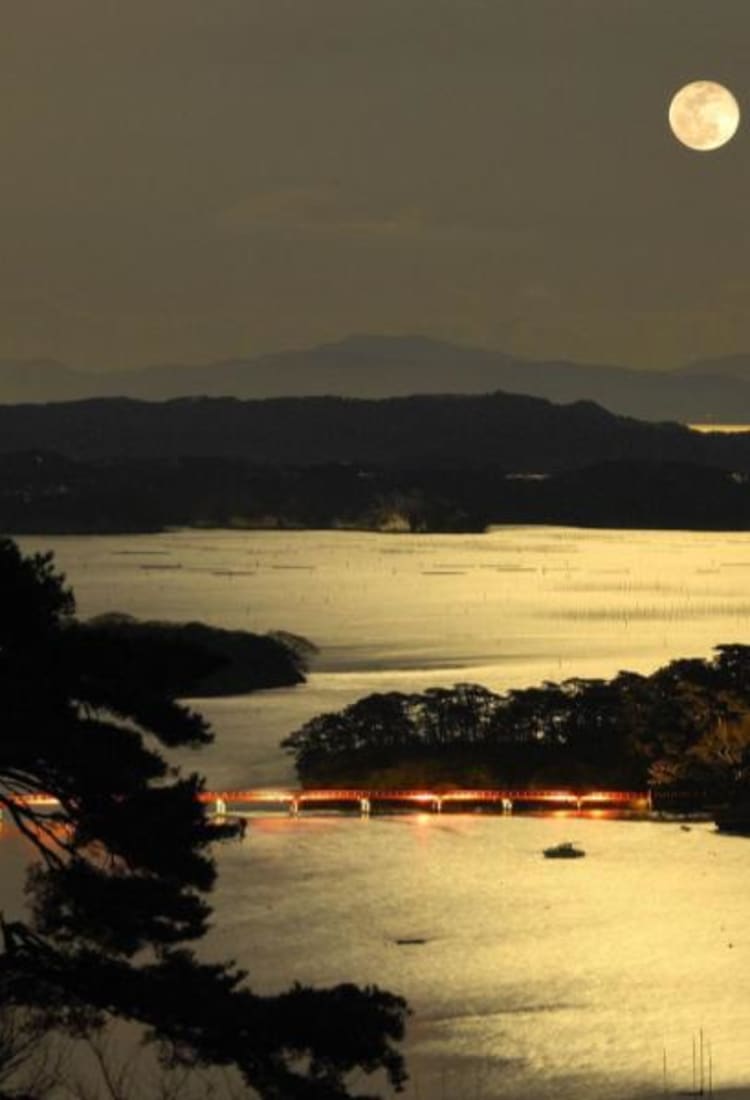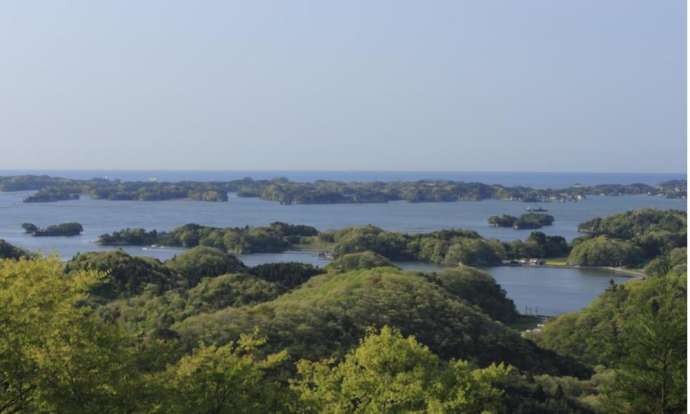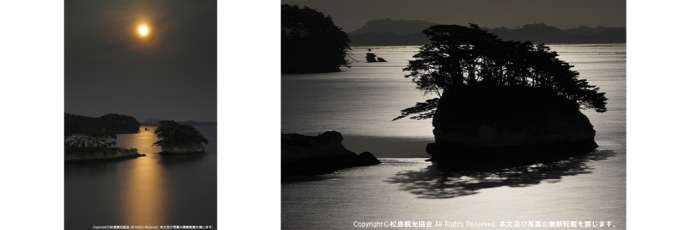
See the pine-clad islands of Matsushima—one of Japan’s three most celebrated scenic sights—under an enchanting full moon
See the pine-clad islands of Matsushima—one of Japan’s three most celebrated scenic sights—under an enchanting full moon
A gorgeous autumn moon shows Matsushima at its most beautiful

Anyone who’s looking to delight in Japan’s most exquisite vistas will doubtless be satisfied with a trip to Matsushima, whose charms have attracted visitors for generation after generation. The sight of some 260 islands of all sizes dotting Matsushima Bay is so stunningly beautiful that it stands alongside the winding sandbar of Amanohashidate in Kyoto and the iconic torii gate at Miyajima in Hiroshima as one of the three best views in all of Japan.
Matsushima is thought to have taken on its archipelagic shape some five thousand years ago. Tectonic shifts following the last ice age caused a portion of this hilly region to sink, eventually giving rise to the 260 or so islands here when warming temperatures drove up sea levels. Carved out of eons of time, it is a scene that profoundly communicates the grandeur of nature untouched by human hands.
There is one thing, however, that has the power to put this gorgeous marriage of islands and sea on par with the most beautiful sights in the world: the light of the full moon in autumn.

For a few days on either side of the full moon, Matsushima Bay turns golden as it reflects the light of the just-rising autumn moon—creating a phenomenon known as kinpa, or “the golden waves”. Not long afterwards, as the moon nears the midheaven, the water sparkles with silvery ginpa waves. This stunning moment-by-moment transformation as moon, sea, and islands dance together creates an unfolding visual delight that happens nowhere else in the world.
The moon over Matsushima has enchanted some of history’s greatest minds

Western cultures also celebrate the autumn full moon, often calling it the Harvest Moon, Blood Moon, or Hunter’s Moon. It is in Asia, however—places like China, Taiwan, and Korea—where the culture of gazing at the moon in adoration has the deepest, most ancient roots. In Japan too, delighting in the sight of the autumn moon poised perfectly in the fresh, clear skies is one of the most treasured delights of the season. The beautifully rounded mid-autumn moon (known as chushu no meigetsu) is thought to be particularly lovely, inspiring moon-viewing events across the country (see note 1).
Note 1: The mid-autumn moon falls on September 24 in 2018, and will become perfectly full the following day, on September 25. Japan also has a tradition of viewing the following moon on the thirteenth night of its cycle (jusanya), which falls on October 21 this year.
Matsushima has long been one of Japan’s most famous moon-viewing spots, a beloved scene that has inspired countless poems, stories, and paintings over the generations. The Date clan took over this area in 1601, ruling it for more than 200 years. The daimyo even had the Kanrantei teahouse constructed here for the purpose of gazing at the moon, to be later enjoyed by successive heads of the family. The characters used to write “kan-ran” mean “admiring the ripples”; the teahouse is also sometimes known as the “moon-viewing palace”. The sight of Matsushima Bay spreads out before the structure, which is positioned perfectly to gaze at the moon rising out of the sea. It is open to visitors to this day, and offers an extraordinary sight each year around the night of the Harvest Moon.
Haiku poetry (see note 2) is known for its ability to condense vivid scenes and deep emotion into a tiny composition highlighted by key seasonal themes. The world-famous haiku master Matsuo Basho loved the moon at Matsushima, his passion for it driving him to make the journey to see it himself. On the way, he kept a travel journal that he filled with haiku poems—though mysteriously, he never actually composed one about Matsushima itself. Commenting on the omission, one of his disciples wrote, “Basho was likely so overcome with feeling at the beauty of the scene that words failed him, rendering him incapable of producing a haiku.”
Illustrious figures came from outside Japan as well. The renowned physicist Albert Einstein is among the great men and women who have been captivated by the Matsushima moon. On his 1922 visit, a local newspaper reported that Einstein “was so moved gazing at the sight of the rising moon that he let out a cry of deep feeling.”
Note 2: Haiku are short poems comprised of seventeen syllables in three lines. One of the three lines must contain a seasonal expression, known as a kigo.
Stroll around to the famous sights and take in all the varied beauty of Matsushima

No matter how beautiful the moon at Matsushima may be, travelers on a nighttime sightseeing adventure want to be able to relax and enjoy their evening meal and accommodations as well. Luckily, Matsushima puts all those concerns at ease. Scenic inns and hotels offering lovely views are dotted along Matsushima Bay, ensuring that visitors can enjoy a comfortable stay as well as the breathtaking sights. Some of them offer ocean views in every room and outdoor hot spring pools that make it possible to admire the moon while enjoying a relaxing soak.
You may come to Matsushima for the nighttime views, but it would be a shame to miss out on its daytime charms. The best way to take in all the beauty of its many lovely islands is from a cruise boat gliding along the water. There are several cruise packages available, so it’s easy to pick one that fits your schedule. Tours are available with and without reservations.
There are also some great vantage points from land as well. There are four outlooks, collectively known as the shidaikan, positioned around the bay. The Yukan and Reikan outlooks are in the town of Matsushima, the Ikan outlook is in Shichigahama, and the Sokan outlook is in Higashi-Matsushima city. All are located a bit outside the center of Matsushima and require some walking from their respective parking areas, but rest assured that any effort will be richly rewarded by the stunning views of Matsushima that await.
Nature offers some additional bounty during fall in Matsushima in the form of delicious local oysters, in season between October and March, and anago eel, in season between June and September. Don’t miss out on these delicacies when you make your trip!
For more information, visit the Matsushima Tourism Association website:




























































